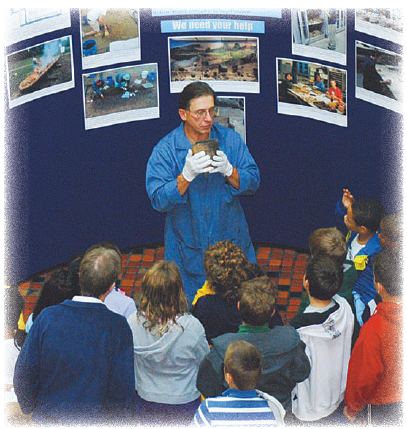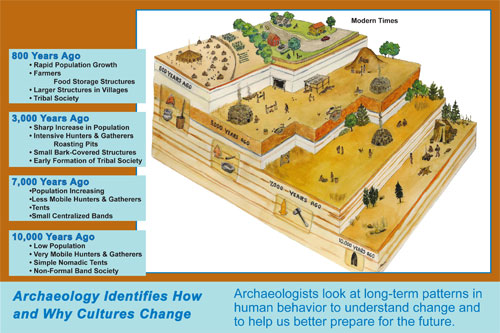Value of Archaeology
Archaeology always seems to conjure up images of the exotic. When we tune in to the History Channel or National Geographic specials, we are swept away to Egypt or China or perhaps Mesa Verde. Images of pyramids, cliff dwellings, and spectacular artifacts of gold or turquoise come to mind. While all of those amazing places and fabulous objects are familiar to most of us, they're so compelling that they sometimes mask a more important and poorly understood fact: every place has a past, and every past is important. That's especially true here in Pennsylvania.
The area that is now the Commonwealth was settled by Native American people more than 16,000 years ago, during the end of the Ice Ages. In fact, one of the oldest radiocarbon dated sites in North America, the Meadowcroft Rockshelter, is located in southwestern Pennsylvania. The descendants of those first people lived in literally every corner of Pennsylvania, and left behind a rich and important record of their history and cultures. Thousands of Native American archaeological sites of every kind, from small temporary campsites to villages of thousands of people, dot the Commonwealth's landscape. That's also true of sites created since the first colonists arrived here in the seventeenth century. From Independence Mall to Fort Necessity to Gettysburg to thousands of lesser known places, important evidence from many critical moments in America's history are buried beneath Pennsylvania's landscape. From time to time, evidence of this underground legacy turns up as arrowheads or fragments of pottery in plowed fields, an old foundation along a roadside, or dark stains visible in a stream-side cut bank.

What is Archaeology?
Archaeology is the study of past human behavior through the systematic recovery and analysis of material remains or objects. These objects, called artifacts, can be as small as a button or as large as a building. Either large or small, they are the evidence of past cultures. These artifacts are proof of those before us and serve as a physical connection to our past.
Archaeology is divided into prehistoric and historical archaeology. Prehistoric archaeology is the study of cultures that did not have a written language. Although prehistoric peoples did not write about their culture, they left remains such as tools, pottery, ceremonial objects, and dietary refuse. Historical archaeology studies the remains of cultures for which a written history exists. Historical archaeology examines records from the past that include diaries; court, census, and tax records; deeds; maps; and photographs. Through combining the use of documentation and archaeological evidence, archaeologists gain a better understanding of the past and human behavior.
Why is Archaeology Important?
The goal of archaeology is to understand how and why human behavior has changed over time. Archaeologists search for patterns in the evolution of significant cultural events such as the development of farming, the emergence of cities, or the collapse of major civilizations for clues of why these events occurred. Ultimately, they are searching for ways to better predict how cultures will change, including our own, and how to better plan for the future.

Archaeology is not only the study of these broad issues but also provides a history and heritage to many cultures. Nothing would be known of the cultural developments of prehistoric peoples if it were not for archaeology. Additionally, archaeology paints a picture of everyday life for groups such as slaves, coal miners, and other early immigrant workers who were poorly documented by historians.

Today, our culture seems to document everything through books, newspapers, television, and the Internet. However, there is frequently a difference between what is written and what people actually do. Modern media often puts a "spin" on a story that reflects an editorial bias on what has taken place. Although the written record may be tremendously useful, it is biased by the beliefs and mistakes of those who produced them. Archaeology frequently provides a more objective account of our past than the historic record alone.

Our past is our cultural heritage, and how we choose to use this information for future generations is an important role for archaeologists. Understanding patterns and changes in human behavior enhances our knowledge of the past. It aids us in planning, not only our future, but for generations to come. Many people believe that public archaeology is critical to understanding, protecting, and celebrating our rich and diverse cultural heritage. Archaeologists recognize the importance of this role and are developing various mechanisms of media outreach, publications, Internet, and public programs, to publicize the contributions of archaeology.

How do Archaeologists Examine the Past?
Archaeological sites are evidence of human activity often associated with concentrations of artifacts. Excavation of archaeological sites is a destructive process requiring systematic removal of soils and artifacts. Archaeological sites are similar to research laboratories where data is collected, recorded, and analyzed. Controlled excavation and mapping of information relative to the soil layers and the artifacts associated with each layer allows archaeologists to search for patterns in past human behavior. They study these patterns and changes in human behavior over long periods of time, as evidenced in the artifacts. The combination of analysis of activities only present in the soil, such as the stains left by cooking, and the artifacts recovered, survive as the archaeological record of a site

Caring for the Past
Archaeological sites and artifacts on private land in the Commonwealth are the property of the landowner. When they occur on public land or in the path of proposed projects like highways or developments, a number of state and federal laws provide for their study and/or their protection. The intentional excavation or removal of antiquities on public land is a criminal offense forbidden by law. When project construction threatens archaeological sites, archaeologists in the employ of public agencies, consulting firms, or universities work closely with project planners and designers. The archaeologists conduct fieldwork to locate the sites, and preservation of sites in their original location is always the best and first option. When that's not possible, samples of the data and artifacts from the most important sites are carefully excavated prior to construction. The results of these excavations include technical reports, museum collections, public exhibits, films, Web sites, and lesson plans, ensuring that both researchers and taxpayers benefit from our efforts to manage the buried past.
Why Archaeology Matters
Archaeological sites are non-renewable resources; once they're destroyed or excavated by archaeologists, they're gone forever and can't be replaced. The loss is significant. In the end, archaeology isn't about artifacts or excavations or exhibits, it's about people! Our decisions about the future are based on the lessons we learn from those who came before us. The worlds of Native American hunters, Revolutionary War soldiers, 19th century coal miners, pioneer farmers - entire generations of our predecessors and ancestors - can be reconstructed from the things they left behind in archaeological sites. They can still teach us and we can still learn from them. The knowledge and accomplishments of all those past generations are part of our collective heritage as Pennsylvanians. It's a legacy far too valuable to lose.